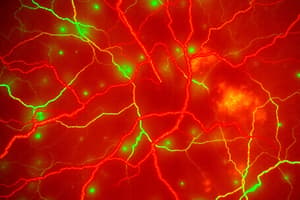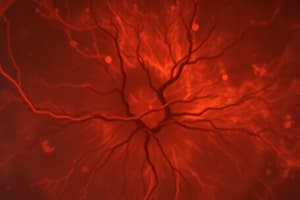Podcast
Questions and Answers
What is the most common symptom in patients with posterior scleritis?
What is the most common symptom in patients with posterior scleritis?
- Eye redness
- Pain (correct)
- Photophobia
- Blindness
Which of the following is a sign of advanced scleromalacia perforans?
Which of the following is a sign of advanced scleromalacia perforans?
- Disc swelling
- Yellow scleral necrotic plaques (correct)
- Macular edema
- Choroidal folds
What is a characteristic feature of uveal effusion?
What is a characteristic feature of uveal effusion?
- Choroidal folds (correct)
- Keratoconjunctivitis sicca
- Macular edema
- Disc swelling
Which imaging technique may be used to diagnose posterior scleritis?
Which imaging technique may be used to diagnose posterior scleritis?
What is the main characteristic of scleromalacia perforans?
What is the main characteristic of scleromalacia perforans?
Which post-treatment result may be observed in posterior scleritis with retinal artery occlusion and exudative detachment?
Which post-treatment result may be observed in posterior scleritis with retinal artery occlusion and exudative detachment?
According to the fluorescein angiogram, which of the following is observed?
According to the fluorescein angiogram, which of the following is observed?
What does the B-scan ultrasound reveal about the right optic nerve?
What does the B-scan ultrasound reveal about the right optic nerve?
After 4 months, what does the fundus show?
After 4 months, what does the fundus show?
Which of the following is a sign associated with scleritis, according to the information provided?
Which of the following is a sign associated with scleritis, according to the information provided?
Which imaging technique is used to assess the resolution of scleral thickness and sub-Tenon's fluid?
Which imaging technique is used to assess the resolution of scleral thickness and sub-Tenon's fluid?
Which of the following systemic associations is listed for scleritis?
Which of the following systemic associations is listed for scleritis?
What is a common sign of nodular episcleritis?
What is a common sign of nodular episcleritis?
How is a first attack of nodular episcleritis typically treated?
How is a first attack of nodular episcleritis typically treated?
What is a distinguishing feature of diffuse anterior non-necrotizing scleritis?
What is a distinguishing feature of diffuse anterior non-necrotizing scleritis?
What is a sign of necrotizing anterior scleritis with inflammation?
What is a sign of necrotizing anterior scleritis with inflammation?
How does nodular anterior non-necrotizing scleritis typically present?
How does nodular anterior non-necrotizing scleritis typically present?
What distinguishes surgically induced granulomatous complications from other conditions mentioned?
What distinguishes surgically induced granulomatous complications from other conditions mentioned?
Flashcards are hidden until you start studying



